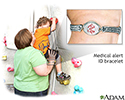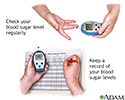Type 2 diabetes - self-care
Type 2 diabetes - managing
Type 2 diabetes is a life-long (chronic) disease. If you have type 2 diabetes, your body has trouble using the insulin it normally makes. Insulin is a hormone made by the pancreas to control blood sugar. When your body's insulin isn't used correctly, the sugar from food stays in the blood and the sugar (glucose) level can get too high.
Most people with type 2 diabetes are overweight when they're diagnosed. The changes in the way the body handles blood sugar that lead to type 2 diabetes usually happens slowly.
Everyone with diabetes should receive proper education and support about the best ways to manage their diabetes. Ask your health care provider about seeing a diabetes educator.
Symptoms of Type 2 Diabetes
You may not have any symptoms. If you do have symptoms, they may include:
- Hunger
- Thirst
- Urinating a lot, getting up more often than usual at night to urinate
- Blurry vision
- Infections
- Trouble having an erection
- Red skin rashes in parts of your body
Take Control of Your Diabetes
You should have good control of your blood sugar. If your blood sugar is not controlled, serious problems called complications can happen to your body after many years.
Learn the basic steps for managing diabetes to stay as healthy as possible. Doing so will help keep the complications of diabetes away. Steps include:
Basic steps for managing diabetes
Hyperglycemia - control; Hypoglycemia - control; Diabetes - blood sugar control; Blood glucose - managing

- Checking your blood sugar at home
- Keeping a healthy diet
- Being physically active
Also, be sure to take any medicine or insulin as instructed.
Your provider will also help you by ordering blood tests and other tests. These help make sure your blood sugar and cholesterol levels are each in a healthy ranges. Also, follow your provider's instructions about keeping your blood pressure in a healthy range.
Your doctor will likely ask you to visit other providers to help you control your diabetes. These providers include a:
- Dietitian
- Diabetes pharmacist
- Diabetes educator
Eat Healthy Foods and Manage Your Weight
Foods with sugar and carbohydrates can raise your blood sugar too high. Alcohol and other drinks with sugar can also raise your blood sugar. A nurse or dietitian can teach you about good food choices .
Teach you about good food choices
When you have type 2 diabetes, taking time to plan your meals goes a long way toward controlling your blood sugar and weight.
Make sure you know how to have a balanced meal with protein and fiber. Eat healthy, fresh foods as much as possible. DO NOT eat too much food at one sitting. This helps keep your blood sugar in a good range.
Managing your weight and keeping a well-balanced diet are important. Some people with type 2 diabetes can stop taking medicines after losing weight (even though they still have diabetes). Your provider can let you know a good weight range for you.
Weight-loss surgery may be an option if you are obese and your diabetes is not under control. Your doctor can tell you more about this.
Exercise
Regular exercise is good for people with diabetes . It lowers blood sugar. Exercise also:
Exercise is good for people with diabet...
No definition available for this article.

- Improves blood flow
- Lowers blood pressure
It helps burn extra fat so that you can keep your weight down. Exercise can even help you handle stress and improves your mood.
Try walking, jogging, or biking for 30 to 60 minutes every day. Pick an activity that you enjoy and you are more likely to stick with. Bring food or juice with you in case your blood sugar gets too low. Drink extra water.
Wear a diabetes ID bracelet. In case of an emergency, people know you have diabetes and can help you get the right medical attention.
Always check with your provider before beginning an exercise program. Your provider can help you choose an exercise program that is safe for you.
Check Your Blood Sugar
You may be asked to check your blood sugar at home . This will tell you and your provider how well your diet, exercise, and medicines are working. A device called a glucose meter can provide an accurate blood sugar reading.
Check your blood sugar at home
Diabetes - home glucose testing; Diabetes - home blood sugar testing

A doctor, nurse, or diabetes educator will help set up a home testing schedule for you. Your doctor will help you set your blood sugar goals.
- Many people with type 2 diabetes need to check their blood sugar only once or twice a day. Some people need to check more often.
- If your blood sugar is in control, you may need to check your blood sugar only a few times a week.
You may Need Medicines
If diet and exercise are not enough, you may need to take medicine. It will help keep your blood sugar in a healthy range.
There are many diabetes medicines that work in different ways to help control your blood sugar. Many people with type 2 diabetes need to take more than one medicine to control their blood sugar. You may take medicines by mouth or as a shot (injection). Diabetes medicines may not be safe if you are pregnant. So, talk to your doctor about your medicines if you're thinking of becoming pregnant.
If medicines don't help you control your blood sugar, you may need to take insulin. Insulin must be injected under the skin. You'll receive special training to learn how to give yourself injections. Most people find that insulin injections are easier than they thought.
Learn to Prevent Long-term Problems of Diabetes
People with diabetes have a high chance of getting high blood pressure and high cholesterol. You may be asked to take medicine to prevent or treat these conditions. Medicines may include:
- An ACE inhibitor or another medicine called an ARB for high blood pressure or kidney problems.
- A medicine called a statin to keep your cholesterol low.
- Aspirin to keep your heart healthy.
DO NOT smoke. Smoking makes diabetes worse. If you do smoke, work with your provider to find a way to quit.
Diabetes can cause foot problems. You may get sores or infections. To keep your feet healthy:
-
Check and care for your feet
every day
Check and care for your feet
Diabetes - foot care - self-care; Diabetic foot ulcer - foot care; Diabetic neuropathy - foot care
 ImageRead Article Now Book Mark Article
ImageRead Article Now Book Mark Article - Make sure you're wearing the right kind of socks and shoes
See Your Doctor Regularly
If you have diabetes, you should see your provider every 3 months, or as often as instructed. At these visits, your provider may:
- Ask about your blood sugar level
- Check your blood pressure
- Check the feeling in your feet
- Check the skin and bones of your feet and legs
- Examine the back of your eyes
Your provider will also order blood and urine tests to make sure your:
- Kidneys are working well (every year)
- Cholesterol and triglyceride levels are healthy (every year)
- A1C level is in a good range for you (every 6 months if your diabetes is well controlled or every 3 months if it is not)
Talk to your provider about any vaccines you may need, such as the yearly flu shot and the hepatitis B and pneumonia shots.
Vaccines
Papillary carcinoma of the thyroid is the most common cancer of the thyroid gland. The thyroid gland is located inside the front of the lower neck....

Visit the dentist every 6 months. Also, see your eye doctor once a year, or as often as instructed.
References
Brownlee M, Aiello LP, Cooper ME, Vinik AI, Plutzky J, Boulton AJM. Complications of diabetes mellitus. In: Melmed S, Polonsky KS, Larsen PR, Kronenberg HM, eds. Williams Textbook of Endocrinology . 13th ed. Philadelphia, PA: Elsevier; 2016:chap 33.
Dungan KM. Management of type 2 diabetes mellitus. In: Jameson JL, De Groot LJ, de Kretser DM, et al, eds. Endocrinology: Adult and Pediatric . 7th ed. Philadelphia, PA: Elsevier Saunders; 2016:chap 48.
Standards of medical care in diabetes-2016: summary of revisions. Diabetes Care . 2016;39 Suppl 1:S4-S5. PMID: 26696680 www.ncbi.nlm.nih.gov/pubmed/26696680 .
-
Medical alert bracelet - illustration
People with diabetes should always wear a medical alert bracelet or necklace that emergency medical workers will be able to find. Medical identification products can help ensure proper treatment in an emergency.
Medical alert bracelet
illustration
-
Manage your blood sugar - illustration
Checking your blood sugar levels often and writing down the results will tell you how well you are managing your diabetes so you can stay as healthy as possible. The best times to check your blood sugar are before meals and at bedtime. Your blood sugar meter may have computer software to help you track your blood sugar level. This is usually available from the manufacturer's website.
Manage your blood sugar
illustration
-
Medical alert bracelet - illustration
People with diabetes should always wear a medical alert bracelet or necklace that emergency medical workers will be able to find. Medical identification products can help ensure proper treatment in an emergency.
Medical alert bracelet
illustration
-
Manage your blood sugar - illustration
Checking your blood sugar levels often and writing down the results will tell you how well you are managing your diabetes so you can stay as healthy as possible. The best times to check your blood sugar are before meals and at bedtime. Your blood sugar meter may have computer software to help you track your blood sugar level. This is usually available from the manufacturer's website.
Manage your blood sugar
illustration
-
Diabetes
(Alt. Medicine)
-
Diabetes - type 2
(In-Depth)
-
Diabetes - type 1
(In-Depth)
-
Diabetes diet
(In-Depth)
-
Hypoglycemia
(Alt. Medicine)
-
Exercise
(In-Depth)
-
Weight control and diet
(In-Depth)
-
Stroke
(In-Depth)
-
Low back pain
(Alt. Medicine)
-
Asthma
(Alt. Medicine)
Review Date: 8/7/2016
Reviewed By: Brent Wisse, MD, Associate Professor of Medicine, Division of Metabolism, Endocrinology & Nutrition, University of Washington School of Medicine, Seattle, WA. Also reviewed by David Zieve, MD, MHA, Isla Ogilvie, PhD, and the A.D.A.M. Editorial team.


